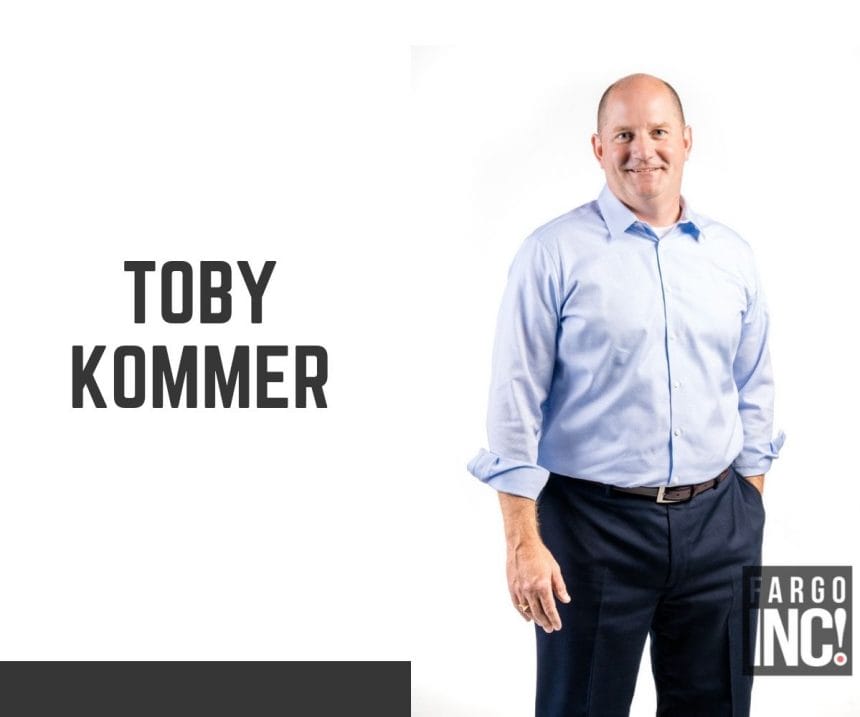Photo by Hillary Ehlen
You’re an expert in your industry. That’s why you became an entrepreneur. But, you don’t know anything about corporate structure, tax filings, loans, HR or the thousands of other minutiae you deal with every day.
At Fargo INC, we want to help businesses grow. That’s why we found 10 business owners and executives and asked them for their toughest business questions. We then paired them up with an expert in that industry. Here are your questions answered.
Financial Expert
Toby Kommer
Owner of Haga Kommer
Business owner
Dave Diebel
Producer/Co-Owner of D&N Cinematics, Bismarck
What’s the best thing business owners can do to ensure they’re on a good path for retirement?
The answer to this question is actually part of the question. We encourage business owners to work backward from their retirement date in terms of planning in order to set a path and fully understand the steps in that path. We encounter many business owners that don’t understand how much of a retirement fund they need or they have an arbitrary number in mind. The other important part to this process is understanding that not every dollar has the same after-tax value. $100,000 taxed at 30 percent is much different than $100,000 taxed at 20 percent when it comes to cash available from investment assets after retirement. It’s important that business owners work with advisors that understand that difference and also the unique opportunities and challenges of planning with business owners, especially because the sale of their business is often times the largest source of retirement funds. In terms of retirement plans, there are several different options for business owners depending on the type of business they have and how they wish to involve their employees. For example, SEP IRA’s can be great options for self-employed business owners with no employees but aren’t the choice for larger companies. However, selecting the right investment vehicles should be the second step in the plan, understanding the desired endpoint is the first step and is critical to setting the path.
Once the business owner discovers the after-tax cash flow they need in retirement, we work with them to help them understand how to achieve that number. For most business owners, this requires an understanding of what their business is worth or will be worth at a point in the future. Our business valuation team has worked with many business owners to help them understand the value of their business and, more importantly, what they can do prior to retirement to enhance that value and how to structure a sale in the most tax-efficient manner. Retirement planning should occur during all phases of business ownership, but if the sale of a business is involved, it is especially important to have in-depth planning conversations at least 3-5 years prior to any sale. Working with business advisors that are entrepreneurial themselves is essential to this process, you want to work with an advisor that has purchased or sold a business for themselves in the past. These types of advisors understand not only the theory behind the numbers but also the mental obstacles that can occur for both the buyers and the sellers. Receiving the most value for the seller takes creativity in putting the transaction together. There are an infinite number of ways to structure the sale of a business. Working with an advisor that understands the unique nature of each transaction is key. For most business owners, they will only sell a business once in their life and working with a skilled advisor is key.
What are some common mistakes that could be costing a business money?
The number one mistake we see from business owners that costs their business money is not fully understanding or tracking the performance of their business. We encourage business owners to work with their CPA to create an annual budget and, more importantly, a process for analyzing the business performance on a monthly basis. Reviewing actual to budget results on a monthly basis along with industry comparisons, helps business owners truly understand their numbers and to react in a timely fashion. Too often, we hear from business owners that look back on the prior year and wonder where exactly they spent their money or why they had record sales but don’t have the cash flow to show for it.
The business environment changes quickly. Having a process to review your actual results on a monthly basis with a qualified business advisor is essential to understanding how your business is performing and where improvements can be made. These monthly or quarterly meetings allow the business owner to step back from the daily grind of running the business and focus on the results and the trajectory of the business. A process for this type of review can lead to questions such as:
- Why are my personal expenses higher than the industry average?
- Can I be more efficient and effective by outsourcing certain functions?
- Do I truly understand the cost to produce each product or service within my business?
- Which products/services are the most profitable?
It can also lead to money-saving ideas such as requoting the business insurance if it has not been reviewed in the last three years or consolidating a series of smaller bank loans into one blanket loan. For more complex business owners, we suggest rolling 12-month projections versus just a stagnant budget. This process allows the business owner to understand and respond very quickly to revenue, expense and cash flow changes.
As a business, how can you determine if you’re paying too much in taxes?
The most important factor in the answer to this question is to ensure you have a proactive CPA. As a business owner, if you are not meeting with your CPA periodically during the year, chances are you are paying more in taxes than you may need to pay. We like to meet with our business clients at least once per year for an in-depth tax planning session in the fall. It is important to be proactive and not wait until the year is over and the opportunity to take advantage of tax planning strategies has passed due to the deadlines. Often times, we find new clients are frustrated by the lack of proactive advice they have received in the past. It’s not necessarily that they have lost out on tax-planning strategies but rather the lack of communication regarding what may be available.
You must do your part as a business owner as well. Consistent communication with your CPA is key. Making the CPA an integral part of your business discussions allows your CPA to understand what new tax programs or deductions may be available for your industry or to develop tax strategies that fit the income stage that your business is currently in and may be in further into the future. The recent tax law changes were some of the largest in history, so now is a good time to review everything from your entity structure to your overall business plan with your CPA. In addition, there are a number of both state and federal tax credits that are available depending on the industry, so working with a CPA that keeps current on these programs is critical.
Any tips on increasing the expediency of accounts receivable?
Process is the key to managing accounts receivable. It all starts with the process for screening new clients and the expectations set up during the onboarding process of new clients. We encourage our clients to work with their attorney to ensure their contracts address items that can make the collection process easier, such as personal guarantees and late penalties. Many times, businesses dedicate a great deal of resources to the sale and the sales process and rightfully so because, as the old saying goes, nothing happens until a sale is made. However, after the sale is made, it is just as important to understand, document and manage that process. There are a few keys to managing accounts receivable:
Review the AR aging report weekly and have a defined process for following up, such as a call after the invoice is 10 days past due, a written reminder at 20 days and a certified letter at 30 days.
Move quickly on past due accounts. Studies have shown that the longer receivables go uncollected, the less likely they are to ever be collected, either partially or in full. So day 45 is not the time to contact a client about a payment that was due on day 30.
Make the process easy for the client. That may mean the ability to pay online, return envelopes or payment vouchers depending on your industry. The easier the process, the quicker the payment comes.
There are several great technology applications on the market right now that make the bill presentation and payment process easy for the client and offer multiple ways to pay and integrate with the various accounting systems. The key is to ensure that someone in the company has the ultimate responsibility of managing the AR function and the process is well defined. This should include, whenever possible, offering or requiring the client the opportunity to pay when the service is rendered or the product is delivered.
A systematic and preferably automated method of invoicing and reminding clients of their obligations is also key. Often times, we hear from business owners that they don’t want to offend their clients for pushing too hard regarding AR collection. This way of thinking will almost guarantee more charge offs, especially if you are dealing with other businesses as clients. All business owners understand the importance of AR collection and if you allow clients to “slow pay” you, then, unfortunately, they are showing you they don’t value what you bring to the table.
When is it a good time to take out a loan or raise capital to facilitate growth?
Business owners need to work with a business advisor that can help them with the concept of Return on Equity (ROE) or Return on Investment (ROI) when taking on new debt and especially when looking to raise capital through outside investors.
When considering taking on new debt for the company, it is key to understand the ROI regarding the potential use of the debt. (For example, if a business owner is taking out a loan of $100,000 at seven percent interest in order to help the business earn another $20,000 per year.) A decision such as this should be reviewed with their business advisor to understand the risks associated with the ROI on the debt. The example above is a fairly simplistic example. In reality, these types of decisions usually require ramp up time before the investment begins to result in increased profit, which must also be taken into consideration.
Business owners in different industries have different internal targets for ROI or ROE, however, 15-20 percent can be fairly common. The first step in understanding and evaluating your ROI or ROE target is understanding the current ROI or ROE of the company. This helps the business owner understand their risk tolerance and set future thresholds for assisting with the decision to grow or expand through the use of debt or additional capital.
It is also very important to understand as a business owner where you are at in the business life cycle in comparison to the retirement goals we discussed in the earlier question. Depending on the ROI of the investment along with the ramp up time, a decision a business owner makes at age 55 may be different from the one he or she makes at age 45. Modeling out these scenarios with your CPA or other business advisors allows you to make an informed decision, and, as we discussed in an earlier question, the costs and revenues of such an investment should be carefully budgeted and tracked on a monthly basis to allow you to analyze your decisions and adjust accordingly if needed. Remember “hope” is not a strategy. Too often, we see business owners spend money and hope for the best rather than analyze the ROI of such a decision before acting and tracking the results in order to make adjustments as needed.
What’s ‘Appening With Cashflow?
There are numerous cashflow and predictive accounting softwares out there. These are some of the top-rated ones on Producthunt.com, a website that compares and ranks different software.
YayPay
YayPay makes accounts receivable more productive and predictable. They do this through unpaid or late invoices, inaccurate data, predictive cash flow reports and more.
yaypay.com
Cashflowy
Enter your current available balance along with all of your income and expenses and Cashflowy will show your future balance going forward. You will see how your cashflow grows and shrinks over time.
Search Cashflowy on the App Store
Baremetrics Forecasting
Baremetrics helps predict cashflow, predict your customer needs, provides email reports, gives you easy to use dashboards and much more.
baremetrics.com
Cashvue
Cashvue is an active cash flow management platform for companies. A finance team at a company can project, adjust and manage all current and upcoming cash activity and provide a live up to date runway and a future vision of company’s financial health.
cashvue.com
Satago
This software offers a credit control tool, risk insights, cashflow management and more.
satago.com
Hubdoc
Receipt management is a pain in the a$$. We have drawers full of folders of receipts from before we switched over to Hubdoc. Now, this intuitive software saves us time because all we have to do is snap a picture or forward an email and Hubdoc will automatically track and classify that receipt.
hubdoc.com








